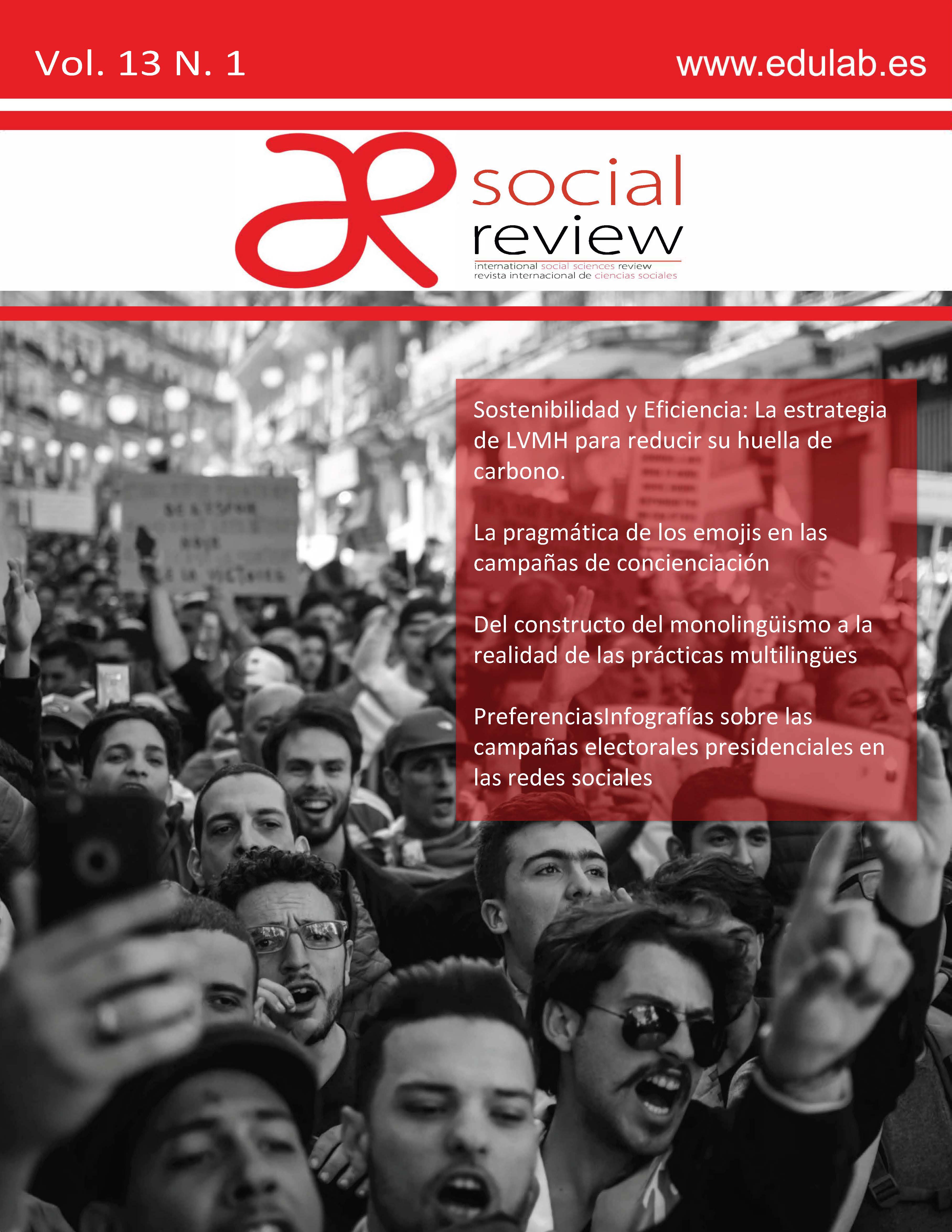Sostenibilidad y Eficiencia: La estrategia de LVMH para reducir su huella de carbono
DOI:
https://doi.org/10.62701/revsocial.v13.5418Palabras clave:
Sostenibilidad, Responsabilidad Social Corporativa (RSC), Lujo, Eficiencia, Huella de carbono, Cambio climático, EstrategiaResumen
Para analizar la eficiencia en la reducción de la huella de carbono en el sector del lujo, se estudia el grupo LVMH, comparando sus emisiones de gases de efecto invernadero, medidas en CO2 según el IPCC, con sus ingresos y las iniciativas de responsabilidad social corporativa (RSC). Se identifican las medidas de RSC que más contribuyen a la protección ambiental. Estos hallazgos son extrapolables a otros sectores. La eficiencia en la huella de carbono se alinea con la Agenda 2030 de la ONU, que insta a las empresas a implementar estrategias sostenibles y eficaces para combatir el cambio climático.
Descargas
Estadísticas globales ℹ️
|
434
Visualizaciones
|
1076
Descargas
|
|
1510
Total
|
|
Citas
Amatulli, C., De Angelis, M., Korschun, D., & Romani, S. (2018). Consumers’ perceptions of luxury brands’ CSR initiatives: An investigation of the role of status and conspicuous consumption. Journal of Cleaner Production, 194, 277-287. https://doi.org/10.1016/j.jclepro.2018.05.111 DOI: https://doi.org/10.1016/j.jclepro.2018.05.111
Bae, S. Y. (2019). Luxury, sustainability, and the future—The case study of Burberry -. The Research Journal of the Costume Culture, 27(1), 64-71. https://doi.org/10.29049/rjcc.2019.27.1.064 DOI: https://doi.org/10.29049/rjcc.2019.27.1.064
Barnett, M. L., Henriques, I., & Husted, B. W. (2020). Beyond good intentions: Designing CSR initiatives for greater social impact. Journal of Management, 46(6), 937-964. https://ssrn.com/abstract=3506963 DOI: https://doi.org/10.1177/0149206319900539
Belz, F. M., & Schmidt-Riediger, B. (2010). Marketing strategies in the age of sustainable development: Evidence from the food industry. Business Strategy and the Environment, 19(7), 401–416. https://doi.org/10.1002/bse.649 DOI: https://doi.org/10.1002/bse.649
Berg, A., Granskog, A., Lee, L., & Magnus, K. H. (2020). Fashion on climate. McKinsey & Company. https://www.mckinsey.com/~/media/mckinsey/industries/retail/our%20insights/fashion%20on%20climate/fashion-on-climate-full-report.pdf
BHP. (2020). BHP Scope 1, 2 and 3 Emissions Calculations Methodology 2020. https://www.bhp.com/-/media/documents/investors/annual-reports/2020/200908_bhpscope12and3emissionscalculationmethodology2020.pdf.
Brewer, M. K. (2019). Slow fashion in a fast fashion world: Promoting sustainability and responsibility. Laws, 8(4), 24. https://doi.org/10.3390/laws8040024 DOI: https://doi.org/10.3390/laws8040024
Browne, M.A., Crump, P., Niven, S.J., Teuten, E., Tonkin, A., Galloway, T., & Thompson, R. (2011). Accumulation of Microplastic on Shorelines Woldwide: Sources and Sinks. Environmental Science & Technology, 45(21), 9175–9179. https://doi.org/10.1021/es201811s DOI: https://doi.org/10.1021/es201811s
Carroll, A. B., & Buchholtz, A. K. (2014). Business and society: Ethics, sustainability, and stakeholder management. Cengage Learning.
Carroll, A. B. (2021). Corporate Social Responsibility: Perspectives on the CSR Construct's Development and Future. Business & Society. https://doi.org/10.1177/00076503211001765 DOI: https://doi.org/10.1177/00076503211001765
Cervellon, M. C. (2013). Conspicuous conservation: Using semiotics to understand sustainable luxury. International Journal of Market Research, 55(5), 695-717. https://doi.org/10.2501/IJMR-2013-030 DOI: https://doi.org/10.2501/IJMR-2013-030
Chapagain, A.K., Hoekstra, A.Y., Savenije, H.H., & Gautam, R. (2006). The water footprint of cotton consumption: An assessment of the impact of worldwide consumption of cotton products on the water resources in the cotton producing countries. Ecological Economics, 60(1), 186–203. https://doi.org/10.1016/j.ecolecon.2005.11.027 DOI: https://doi.org/10.1016/j.ecolecon.2005.11.027
Charter, M., Peattie, K., Ottman, J., & Polonsky, M. J. (2006). Marketing and Sustainability. Centre for Business Relationships, Accountability, Sustainability and Society (BRASS). http://www.cfsd.org.uk/smart-know-net/links/smart-know-net.pdf
Choi, T. M. (2014). Luxury fashion branding: Literature review, research trends, and research agenda. In T.-M. Choi (Ed.), Fashion branding and consumer behaviours, international series on consumer science (pp. 7–16). Springer. https://doi.org/10.1007/978-1-4939-0277-4_2 DOI: https://doi.org/10.1007/978-1-4939-0277-4_2
Claro, D.P., Laban Neto, S.A. & De Oliveira Claro, P.B. (2013). Sustainability drivers in food retail. Journal of Retailing and Consumer Services, 29, 365-371. https://doi.org/10.1016/j.jretconser.2013.02.003 DOI: https://doi.org/10.1016/j.jretconser.2013.02.003
D'Arpizio, C., Levato, F., Steiner, A., & Montgolfier J. (2024, January 18). Long Live Luxury: Converge to Expand through Turbulence. Bain & Company. https://www.bain.com/insights/long-live-luxury-converge-to-expand-through-turbulence/
Deloitte. (2023). Global Powers of Luxury Goods 2023. Game changing steps in luxury. https://www.deloitte.com/content/dam/assets-shared/docs/industries/consumer/2024/gx-global-powers-of-luxury-goods-2023.pdf
Deloitte. (2020). Global Powers of Luxury Goods 2020. The new age of fashion and luxury. https://www2.deloitte.com/content/dam/Deloitte/global/Documents/Consumer-Business/gx-consumerbusiness-gplg-2020-report.pdf
Diallo, M. F., Dahmane, N., Gadekar, M., & Schill, M. (2021). CSR actions, brand value, and willingness to pay a premium price for luxury brands: Does long-term orientation matter? Journal of Business Ethics, 169(2), 241-260. https://doi.org/10.1007/s10551-020-04486-5 DOI: https://doi.org/10.1007/s10551-020-04486-5
Downie, J., & Stubbs, W. (2013). Evaluation of Australian companies’ scope 3 greenhouse gas emissions assessments. Journal of Cleaner Production, 56, 156–163. https://doi.org/10.1016/j.jclepro.2011.09.010 DOI: https://doi.org/10.1016/j.jclepro.2011.09.010
Gardetti, M. A. (2017). Sustainable management of luxury. Springer book series on environmental footprints and eco-design of products and processes. Springer. https://doi.org/10.1007/978-981-10-2917-2 DOI: https://doi.org/10.1007/978-981-10-2917-2
Habib, R., White, K., Hardisty, D. J., & Zhao, J. (2021). Shifting consumer behavior to address climate change. Current Opinion in Psychology, 42, 108-113. https://doi.org/10.1016/j.copsyc.2021.04.007 DOI: https://doi.org/10.1016/j.copsyc.2021.04.007
Henry, B., Laitala, K., & Klepp, I.G. (2019). Microfibres from apparel and home textiles: Prospects for including microplastics in environmental sustainability assessment. Science of The Total Environment, 652, 483–494. https://doi.org/10.1016/j.scitotenv.2018.10.166 DOI: https://doi.org/10.1016/j.scitotenv.2018.10.166
Hertwich, E. G., & Wood, R. (2018). The growing importance of scope 3 greenhouse gas emissions from industry. Environmental Research Letters, 13(10), Article 104013. https://doi.org/10.1088/1748-9326/aae19a DOI: https://doi.org/10.1088/1748-9326/aae19a
IPCC Report. (2022). Retrieved from https://www.ipcc.ch/report/ar6/wg3/downloads/report/IPCC_AR6_WGIII_Full_Report.pdf.
Khan, S., & Ahmed, M. (2017). Who are the consumers for sustainable luxury? In 2017 global fashion management conference at Vienna (pp. 181-182). https://doi.org/10.15444/GFMC2017.03.02.03 DOI: https://doi.org/10.15444/GFMC2017.03.02.03
Ki, C., & Kim, Y. K. (2016). Sustainable luxury fashion consumption and the moderating role of guilt. Fashion, Industry and Education, 14(1), 18-30. https://doi.org/10.7741/FIE.2016.14.1.018 DOI: https://doi.org/10.7741/fie.2016.14.1.018
Kunz, J., May, S., & Schmidt, H. J. (2020). Sustainable luxury: Current status and perspectives for future research. Business Research, 13, 541-601. https://doi.org/10.1007/s40685-020-00111-3 DOI: https://doi.org/10.1007/s40685-020-00111-3
Li, J., & Leonas, K. K. (2019). Trends of sustainable development among luxury industry. In Sustainable luxury (pp. 107–126). Springer. https://doi.org/10.1007/978-981-13-0623-5_6 DOI: https://doi.org/10.1007/978-981-13-0623-5_6
López, B., Rangel-Pérez, C., & Fernández, M. (2023). Sustainable strategies in the luxury business to increase efficiency in reducing carbon footprint. Journal of Business Research, 157, 113607. https://doi.org/10.1016/j.jbusres.2022.113607 DOI: https://doi.org/10.1016/j.jbusres.2022.113607
LVMH. (2024). Key Documents. https://www.lvmh.com/en/press/key-documents
LVMH. (2023a). LIVE 360. https://www.lvmh.com/group/lvmh-commitments/social-environmental-responsibility/life-initiative-lvmh/
LVMH. (2023b). Social & environmental responsibility. https://www.lvmh.com/group/lvmh-commitments/social-environmental-responsibility/
LVMH. (2020). Environmental reports. https://www.lvmh.com/news-documents/
McKinsey & Company. (2020). The State of Fashion 2020: In search of promise in perilous times. https://www.mckinsey.com/~/media/mckinsey/industries/retail/our%20insights/the%20state%20of%20fashion%202020%20navigating%20uncertainty/the-state-of-fashion-2020-final.pdf
Olatubosun, P., Charles, E., & Omoyele, T. (2021). Rethinking luxury brands and sustainable fashion business models in a risk society. Journal of Design, Business & Society, 7(1), 49-81. https://doi.org/10.1386/dbs_00020_1 DOI: https://doi.org/10.1386/dbs_00020_1
Osburg, V. S., Davies, I., Yoganathan, V., & McLeay, F. (2021). Perspectives, opportunities and tensions in ethical and sustainable luxury: Introduction to the thematic symposium. Journal of Business Ethics, 169(2), 201-210. https://doi.org/10.1007/s10551-020-04487-4 DOI: https://doi.org/10.1007/s10551-020-04487-4
Ozdamar-Ertekin, Z. (2019). Can luxury fashion provide a roadmap for sustainability? Markets, Globalization & Development Review, 4(1). https://doi.org/10.23860/MGDR-2019-04-01-03 DOI: https://doi.org/10.23860/MGDR-2019-04-01-03
Ozdamar-Ertekin, Z., & Atik, D. (2015). Sustainable markets: Motivating factors, barriers, and remedies for mobilization of slow fashion. Journal of Macromarketing, 35(1), 53-69. https://doi.org/10.1177/0276146714535932 DOI: https://doi.org/10.1177/0276146714535932
Pencarelli, T., Gabbianelli, L., & Savelli, E. (2020). The tourist experience in the digital era: The case of Italian millennials. Sinergie Italian Journal of Management, 38(3), 165-190. https://doi.org/10.7433/s113.2020.10 DOI: https://doi.org/10.7433/s113.2020.10
Pirc, U., Vidmar, M., Mozer, A., & Kržan, A. (2016). Emissions of microplastic fibers from microfiber fleece during domestic washing. Environmental Science and Pollution Research, 23(21), 22206–22211. https://doi.org/10.1007/s11356-016-7703-0 DOI: https://doi.org/10.1007/s11356-016-7703-0
Regenerate Fashion (2020). SDG for better fashion. Report 2018-19. Available at: https://regeneratefashion.com/wp-content/uploads/2020/08/SDGs-for-Better-Fashion-Progress-Report-.pdf
. Rukhaya, S., Yadav, S., Rose, N. M., Grover, A., & Bisht, D. (2021). Sustainable approach to counter the environmental impact of fast fashion. The Pharma Innovation Journal, 10(8S), 517-523. https://www.thepharmajournal.com/archives/2021/vol10issue8S/PartH/S-10-7-243-699.pdf
Shashi, K., Centobelli, P., Cerchione, R., & Mittal, A. (2021). Managing sustainability in luxury industry to pursue circular economy strategies. Business Strategy and the Environment, 30(1), 432-462. https://doi.org/10.1002/bse.2630 DOI: https://doi.org/10.1002/bse.2630
Sun, J. J., Bellezza, S., & Paharia, N. (2021). Buy less, buy luxury: Understanding and overcoming product durability neglect for sustainable consumption. Journal of Marketing, 85(3), 28-43. https://doi.org/10.1177/0022242921993172 DOI: https://doi.org/10.1177/0022242921993172
The Fashion Pact. (2020). First steps to transform our industry. https://www.kering.com/api/download-file/?path=Fashion_Pact_2020_Progress_Report_02c1bedfe3.pdf
The Manifiesto. (2019). Unlocking responsible luxury. Retrieved from https://www.som.polimi.it/en/the-manifesto-2019-unlocking-responsible-luxury/
Thomas, S. (2018). Peace of mind: The quintessential luxury. Journal of Design. Business & Society, 4(2), 151–169. https://doi.org/10.1386/dbs.4.2.151_1 DOI: https://doi.org/10.1386/dbs.4.2.151_1
Thorisdottir, T. S., & Johannsdottir, L. (2020). Corporate social responsibility influencing sustainability within the fashion industry. A systematic review. Sustainability, 12(21), 9167. https://doi.org/10.3390/su12219167 DOI: https://doi.org/10.3390/su12219167
United Nations Cf, O. D. D. S. (2015). Transforming our world: the 2030 Agenda for Sustainable Development. United Nations: New York, NY, USA.
UN. (2016). The Paris Agreement. https://www.un.org/en/climatechange/paris-agreement
UN. (2021, November 13). COP26 closes with ‘compromise’ deal on climate, but it’s not enough, says UN chief. https://news.un.org/en/story/2021/11/1105792
Wadera, D., & Kaur, J. (2020). Comparing sustainability practices in luxury brands: A conceptual model. Journal of Asia Entrepreneurship and Sustainability, 3(XV), 151-194. https://d1wqtxts1xzle7.cloudfront.net/111496086/JAESVolXVDec2019-libre.pdf?1708010461=&response-content-disposition=inline%3B+filename%3DHigh_School_Education_in_a_Variety_of_Re.pdf&Expires=1748201121&Signature=WCcOyAzp0~QbnLBiCyPKxjC9Gvnd9k1h1x7Ae9UANDnu9pMQjys-VxJHztzSs74nAGkOAuuJIkDsLLupEFTYcwpOUdszAEZaIdWYb4TZCOI-hYv1Q8dWuiqISx9IB4WRc82LiqFGcUMn6VbmA5uCSdaJGMao0ebv6QA2BCXlP26u85aPw7BPlHfYiWn770I6UG3b1sixBzGl59QcdSOIr3Og33gUFpt-kIMVd0-StYLDA6jkqELCifGX55JBUZRzEpeDEu6MS8MUACPBAgM9t1dpszMQq62TuF4Pcit9kneQX~PgMZt2qu5owVK47XKV5PqFgzDnp6-139VmDu90xQ__&Key-Pair-Id=APKAJLOHF5GGSLRBV4ZA#page=151
Waller, M. A., Fawcett, S. E., & Johnson, J. L. (2015). The luxury paradox: How systems thinking, and supply chain collaboration can bring sustainability into mainstream practice. Journal of Business Logistics, 36(4), 303–305. https://doi.org/10.1111/jbl.12110 DOI: https://doi.org/10.1111/jbl.12110
Willersdorf, S., Hazan, J., Ricci, G., Prénaud, A., Bianchi, F., Seara, J., & Yang, V. (2020, July 21). A new era and a new look for luxury. BCG Global. https://www.bcg.com/publications/2020/new-era-and-new-look-for-luxury
World Economic Forum (2023). The Global Risks Report 2023 (18th ed.). Retrieved from
https://www3.weforum.org/docs/WEF_Global_Risks_Report_2023.pdf
Descargas
Publicado
Cómo citar
Número
Sección
Licencia
Derechos de autor 2025 Los autores/as conservan los derechos de autor y ceden a la revista el derecho de la primera publicación y el derecho de edición

Esta obra está bajo una licencia internacional Creative Commons Atribución-SinDerivadas 4.0.
Los autores/as que publiquen en esta revista aceptan las siguientes condiciones:
- Los autores/as conservan los derechos de autor.
- Los autores/as ceden a la revista el derecho de la primera publicación. La revista también posee los derechos de edición.
- Todos los contenidos publicados se regulan mediante una Licencia Atribución/Reconocimiento-SinDerivados 4.0 Internacional. Acceda a la versión informativa y texto legal de la licencia. En virtud de ello, se permite a terceros utilizar lo publicado siempre que mencionen la autoría del trabajo y a la primera publicación en esta revista. Si transforma el material, no podrá distribuir el trabajo modificado.
- Los autores/as pueden realizar otros acuerdos contractuales independientes y adicionales para la distribución no exclusiva de la versión del artículo publicado en esta revista (p. ej., incluirlo en un repositorio institucional o publicarlo en un libro) siempre que indiquen claramente que el trabajo se publicó por primera vez en esta revista.
- Se permite y recomienda a los autores/as a publicar su trabajo en Internet (por ejemplo en páginas institucionales o personales), una vez publicado en la revista y citando a la misma ya que puede conducir a intercambios productivos y a una mayor y más rápida difusión del trabajo publicado (vea The Effect of Open Access).













